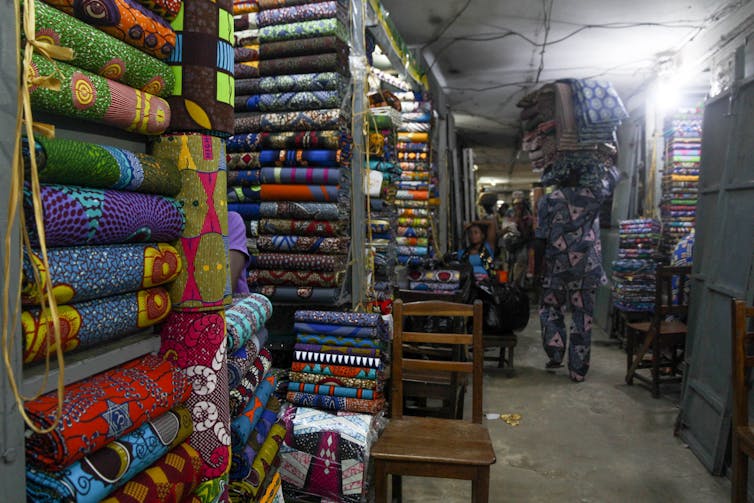
Agbaje Lateef, Ladoke Akintola University of Technology, Ogbomoso
Nigeria’s cotton production has fallen steeply in recent years. It once supported the largest textile industry in Africa. The fall is due to weak demand for cotton and to poor yields resulting from planting low-quality cottonseeds. For these reasons, farmers switched from cotton to other crops.
Nigeria’s cotton output fell from 602,400 tonnes in 2010 to 51,000 tonnes in 2020. In the 1970s and early 1980s, the country’s textile industry had 180 textile mills employing over 450,000 people, supported by about 600,000 cotton farmers. By 2019, there were 25 textile mills and 25,000 workers.
The industry competes in a global textile market that was valued at US$ 993.6 billion in 2021 and is expected to grow at a rate of 4.0% from 2022 to 2030. Once the continent’s leader, Nigeria spends on average US$4 billion a year to import textiles that it could produce itself. Imports put pressure on foreign exchange reserves, jobs and local demand for cotton.
Technical innovation could make the textile sector more competitive – not only by improving cotton production but also by improving textile quality. This can be achieved in Nigeria.
Nowadays, textiles’ properties can be greatly improved through nanotechnology – the use of extremely small materials with special properties. Nanomaterials like graphene and silver nanoparticles make textiles stronger, durable, and resistant to germs, radiation, water and fire.
Adding nanomaterials to textiles produces nanotextiles. These are often “smart” because they respond to the external environment in different ways when combined with electronics. They can be used to harvest and store energy, to release drugs, and as sensors in different applications.
Nanotextiles are increasingly used in defence and healthcare. For hospitals, they are used to produce bandages, curtains, uniforms and bedsheets with the ability to kill pathogens. The market value of nanotextiles was US$5.1 billion in 2019 and could reach US$14.8 billion in 2024.
At the moment, Nigeria is not benefiting from nanotextiles’ economic potential as it produces none. With over 216 million people, the country should be able to support its textile industry. It could also explore trading opportunities in the African Continental Free Trade Agreement to market innovative nanotextiles.
Nanotextiles in Nigeria
Our nanotechnology research group has made the first attempt to produce nanotextiles using cotton and silk in Nigeria. We used silver and silver-titanium oxide nanoparticles produced by locust beans’ wastewater. Locust bean is a multipurpose tree legume found in Nigeria and some other parts of Africa. The seeds, the fruit pulp and the leaves are used to prepare foods and drinks.
The seeds are used to produce a local condiment called “iru” in southwest Nigeria. The processing of iru generates a large quantity of wastewater that is not useful. We used the wastewater to reduce some compounds to produce silver and silver-titanium nanoparticles in the laboratory.
Fabrics were dipped into nanoparticle solutions to make nanotextiles. Thereafter, the nanotextiles were exposed to known bacteria and fungi. The growth of the organisms was monitored to determine the ability of the nanotextiles to kill them.
The nanotextiles prevented growth of several pathogenic bacteria and black mould, making them useful as antimicrobial materials. They were active against germs even after being washed five times with detergent. Textiles without nanoparticles did not prevent the growth of microorganisms.
These studies showed that nanotextiles can kill harmful microorganisms including those that are resistant to drugs. Materials such as air filters, sportswear, nose masks, and healthcare fabrics produced from nanotextiles possess excellent antimicrobial attributes. Nanotextiles can also promote wound healing and offer resistance to radiation, water and fire.
Our studies established the value that nanotechnology can add to textiles through hygiene and disease prevention. Using nanotextiles will promote good health and well-being for sustainable development. They will assist to reduce infections that are caused by germs.
Despite these benefits, nanomaterials in textiles can have some unwanted effects on the environment, health and safety. Some nanomaterials can harm human health causing irritation when they come in contact with skin or inhaled. Also, their release to the environment in large quantities can harm lower organisms and reduce growth of plants. We recommend that the impacts of nanotextiles should be evaluated case by case before use.
Reviving Nigeria’s textile sector
In addition to government’s efforts to revive Nigeria’s textile sector, opportunities in nanotechnology should be explored. Smart nanotextiles that can compete favourably with foreign textiles could be produced locally.
Agriculture can benefit from nanopesticides, nanofungicides and nanofertilizers boosting crop yield. This has been applied to cotton farming. Nanotechnology is also useful to treat effluents of the textile industry in an eco-friendly manner.
Together with higher cotton production, nanotextile products can return Nigeria’s textile industry to glory. This is a unique way to improve Nigeria’s economy by nanotechnology.![]()
Agbaje Lateef, Professor of Microbiology, Ladoke Akintola University of Technology, Ogbomoso
This article is republished from The Conversation under a Creative Commons license. Read the original article.

